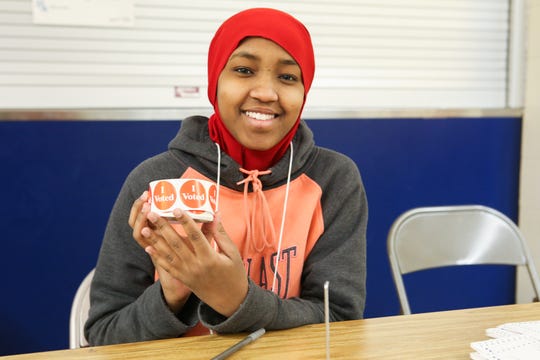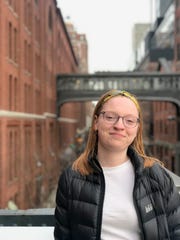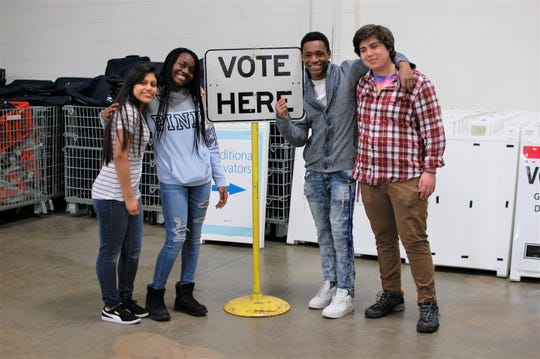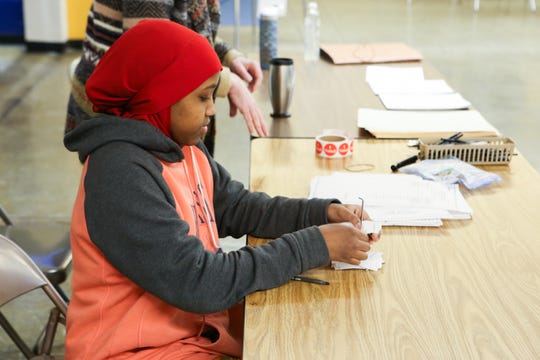There’s a nationwide shortage of poll workers. Cities are relying on teens for help
A Minneapolis student works at a polling place Jan. 21 (Photo: Submitted by City of Minneapolis staff)
MILWAUKEE – In the 2018 midterm elections, Faye Darga was too young to vote, but she wasn’t too young to help. As a junior at Edgewood High School in Madison, Darga signed up as a poll worker at her teacher’s suggestion.
“We’re the next generation, so at some point we’re going to be doing this work and we want to learn,” Darga said.
Though 16- and 17-year-olds are allowed to be poll workers in most states including Wisconsin, not all election officials have sought them out. At a time when clerks around the nation are struggling to recruit enough poll workers, students say they can be part of the solution.
While high school students comprised about 16% of poll workers in Minneapolis, a national model for student recruitment, they comprise less than 1% of poll workers in Milwaukee, an election official estimated.
In 2016, Milwaukee precincts were among the half of Wisconsin polling places that reported difficulty recruiting enough poll workers, who can choose to either volunteer or be paid. When polls are short on workers, there are longer lines for voters and fewer people to assist people with disabilities or other needs.
It’s a rising national issue: About 70% of election officials said they had a hard time recruiting poll workers in 2018, compared with less than half in 2008 and 2012, according to a survey by the U.S. Election Assistance Commission.
“In some instances, people walk away,” said Shauntay Nelson, state director for All Voting is Local who has served as a poll worker in Milwaukee. “Overall, it creates an atmosphere of impatience and frustration, and we don’t want that to be the atmosphere.”
Faye Darga, senior at Edgewood High School in Madison, served as a poll worker in 2018. (Photo: Submitted by Faye Darga)
Just 8% of the state’s polling places had 16- and 17-year-olds serve as poll workers in 2016, according to a Milwaukee Journal Sentinel analysis of state data. State officials stopped collecting this information after 2016.
In Wisconsin and nationally, less than one-fifth of poll workers were younger than 41 years old in the most recent data, while more than two-thirds were 61 years or older.
Election officials who’ve hired student poll workers say that in addition to helping them meet recruitment goals, students tend to be tech-savvy, more diverse and more likely able to help translate for voters who speak other languages.
“When the polling place staff look like you, it’s a more welcoming environment,” said Mike Quieto, assistant clerk in Madison.
To qualify as a poll worker, minors must be 16 or 17, have at least a 3.0 grade point average, and have written permission from a guardian.
Madison has a particularly robust program for recruiting student poll workers. But Quieto looks to Minneapolis as a model.
Students work at a polling place in Minneapolis. (Photo: Submitted by City of Minneapolis staff)
Handling the highest voter turnout in the nation for the midterm elections, Minneapolis had 400 high school students working at 131 of its 132 polling places.
There were so many high school student applicants that the city referred some to neighboring areas.
“They love it, and they’re our future generation, so it’s a win-win situation,” said Grace Wachlarowicz, assistant city clerk and director of elections for Minneapolis.
Minneapolis has used student poll workers since the 1990s but expanded the program in recent years, hiring a part-time staff person who focuses entirely on student workers. They lean on school staff and students who coordinate recruitment in some schools.
Because the student population is more racially and ethnically diverse, Wachlarowicz said, the city has moved closer to its goal of having poll workers reflect the diversity of the communities they serve.
About 44% of the student poll workers spoke two or more languages, and most of those students reported using their language skills to assist voters.
More than 100 Somali-speaking students applied in 2018. Others spoke Spanish, Hmong, Oromo, Amharic and other languages.
Most of the students said the experience improved their skills of working as a team, holding respectful dialogue and solving problems, according to a survey. Most also said they felt more connected to their community and more likely to vote when they turn 18.
Students in Madison shared similar sentiments.
Michael Mays, a senior at Edgewood High School, served as a poll worker in 2018. (Photo: Submitted by Michael Mays)
“It’s a unique hands-on experience you’re not going to get in a classroom,” said Michael Mays, a senior at Edgewood High School. “I just thought it was a really great experience to talk with people. There were a ton of people clearly really passionate and excited about voting.”
Quieto said the students he’s worked with have been reliable and bring fresh perspectives.
“They’re magnificent,” Quieto said. “They pay attention in training, they’re a new set of eyes. Sometimes we’ve had high school workers say, ‘That’s not what we were told in training, are you sure that’s right?’ And all the adults stop and think, ‘As a matter of fact, you’re right.’”
In Wauwatosa, Clerk Melanie Kollmansberger said voters have been happy with high school poll workers and she hopes to recruit more.
“We have received a lot of positive feedback about high school students,” she said.
Minnesota election officials rated their satisfaction with student workers as a 4.67 out of 5, where 5 meant thrilled, according to a 2019 survey by Minnesota Civic Youth, which offers resources for election officials working with students.
Madison officials also work with the University of Wisconsin-Madison to recruit college students — in friendly competition with the University of Minnesota Twin Cities, which had the highest voter turnout in the midterms of the largest public universities in the nation.
“We want to beat Minnesota this year. We were joking about having a gigantic ballot pen that we pass back and forth,” Quieto said.
In Milwaukee, officials haven’t recruited as many high school students. Neil Albrecht, executive director of Milwaukee’s Election Commission, said officials have seen success with a few high-achieving Milwaukee schools but struggled with others.
A Minneapolis student works at a polling place Jan. 21 (Photo: Submitted by City of Minneapolis staff)
Albrecht said while he would like to get more high school students involved, Milwaukee faces greater challenges with poverty than Minneapolis. About 83% of Milwaukee students qualify as economically disadvantaged, compared with 36% in Minneapolis.
“When their focus is on meeting education standards on the most basic level, I think it’s hard for them to engage with us and have students take a day off and work at a polling place,” Albrecht said.
Milwaukee also doesn’t pay poll workers as much as comparable cities. Milwaukee’s rate is $8.67 an hour, compared with Green Bay’s $9.33, Madison’s $13.62, Chicago’s $15.33 and Minneapolis’ $17.15.
Albrecht said the pay “certainly isn’t sufficient compensation for the complexity of the duties they perform.” He noted the job has become harder with increased political pressure and voter ID laws.
“Polling places have really become battlegrounds in the state of Wisconsin,” Albrecht said. “It can create an unpleasant experience for people who receive a stipend but are really for the most part volunteering.”
While volunteering as a poll worker used to be a “natural transition among retirees,” Albrecht said interest is waning.
That’s something Wachlarowicz has noticed, too, in Minneapolis. It’s why her team is so invested in younger people.
“That’s why we’re trying to re-energize our future generations,” she said.
Follow Rory Linnane on Twitter: @RoryLinnane.
Source: Read Full Article



